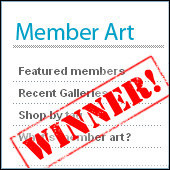EDITOR’S NOTE: Prices and information below may be out of date. Since launching our own art website service for artists at Foliotwist.com, we no longer feel unbiased enough to continue updating or reviewing other art website services. Visit the website below for their most recent information.
Travis Young at Imagekind got back to me this week about last Thursday’s article when I posted my review of Imagekind. I have to say that I’m impressed with his thoroughness in addressing all of the issues I raised, and my opinion of Imagekind has only gone up in regard to their commitment to individual artists who use their services.
Last week’s article included some of the great things about Imagekind, which I’ll sum up today in one simple paragraph.
If you’re an artist, it’s extremely simple to sign up for a free account at Imagekind, and have your own art online within just a few minutes. Each image you upload is then available for others to purchase as a print, and you make money from that without having to deal with credit cards or anything else.
However, in my review I mentioned I did have some concerns.
My primary question was about the final quality and resolution of the art prints. I expressed my shock that Imagekind could accept 100dpi files for fine art printing.
I should have been talking about ppi, since that’s the correct term for digital resolution, as opposed to dpi, which is actually printed resolution.
Travis was kind enough to explain a bit more of their printing system, and eased my mind about the subject.

Although high dpi won’t make up for low ppi, Travis assured me that before the files ever make it to the printer their ppi is adjusted if necessary to compensate for their high-output printing process. Here’s a snippet from the email he sent me.
“Our printing software will also up-sample a file to 360ppi if necessary, according to its own proprietary algorithms. . . rivaling programs like Genuine Fractals and leaping above the traditional result in programs like Photoshop.”
I’d never heard of this type of software, but I’m not on the cutting edge of print technology either. After some quick research into Genuine Fractals, I got some idea as to what the “proprietary algorithms” he mentioned actually do. Essentially they break down the image into a pixel-less mathematical number, and then rebuild it as large as necessary without (almost any) loss of image quality. It’s seems hard to believe, but apparently it works.
Travis also went on to say, “We print using 8 colors of pigment based archival ink (vs. dye ink) . . . on extremely high quality fine art papers. This factor alone produces results unlike anything most are used to seeing on paper. We also utilize a completely color managed printing setup and color profiling exactly developed in conjunction with the printer and paper manufactures.”
So the combination of high-powered printing equipment and some fancy software means a better print for you, even if the image file you’ve uploaded doesn’t have an extremely high resolution.
Of course, they can only do so much with what you give them, so I’d still suggest uploading large, clear scans of your artwork if at all possible. (I’m sure they’d agree.) In addition, the higher ppi your artwork is, the larger your final prints can be.
I’ve noticed so far that a lot of member art is small, around the size of a normal photograph, even though I would imagine that art will be more likely to sell if it’s full-sized. I suppose the people at Imagekind would best know the answer to that however.

“Our Member Art has outsold our Museum Art since day one,” he said. “Though many artists have purchased their own work, our business plan in no way depends on building a community of artists repeatedly [doing so.]”
This was good news to me, as well as a continual call to action for the Imagekind reps. As I stated before, my hope is that the Member’s art will always be higher selling, and that Imagekind’s goal should be to bring in a higher volume of outside purchases.
When I asked Travis if Imagekind had any plans in the future to attract bulk buyers of art, like hotel chains, restaurants, retirement centers, and even galleries or traditional art stores, he replied with “Absolutely, yes,” and went on to say, “We are already a ways down that road, and we think our efforts here will prove to increase the size of that particular sector of the art buying market. . . Decorators, large fulfillment buyers, and others are looking for the same variety, ease of use, and quality changes that Imagekind is bringing forward.”
Travis also mentioned another “big change” coming with improvements of the gallery management tools and uploading process, and I look forward to seeing that as well.
There was a lot more in the email but at the risk of running on too long, I’ll have to leave it for another day. I will continue to keep you updated on Imagekind as I watch it grow (and use it myself) in the coming months.
If you’ve bought art from Imagekind, feel free to join in the discussion and let me know how it turned out. Whether you’re the original artist, or another buyer, you can leave a short message about your experience with Imagekind at my contact page.
This post may contain affiliate links.

